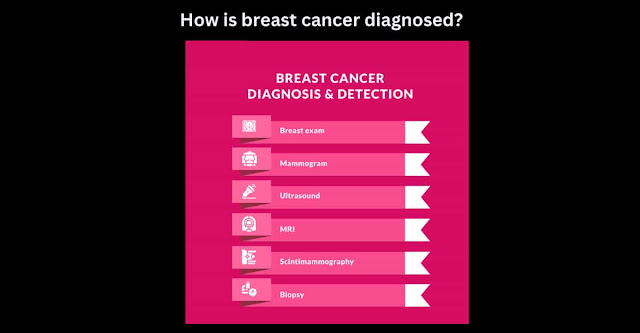Breast Cancer: What is it and how is it treated?
Early diagnosis and treatment give the best results
What is breast cancer?
As the name suggests,
cancer that develops in the cells of the breast is called breast cancer
(tumor). It is one of the most common cancers in women. Over the past few
years, modern medical facilities have helped in early detection. Treatment of
breast cancer, reducing overall breast cancer-related deaths.
Breast cysts are noncancerous
lumps that occur in one or both breasts. They are common and occur naturally
due to changes in the breasts with aging and hormonal changes.
What are the types of breast cancer?
Doctors say that breast cancer is caused by rapid, uncontrolled cell division in cells. Based on the tissues they affect, breast cancer can be:
Ductal carcinoma:
Cancer of the milk-producing ducts
Lobular carcinoma:
Cancer of the glandular tissue
Invasive breast carcinoma:
When the
above-mentioned breast carcinoma spreads to the surrounding tissues, they are
called invasive ductal carcinoma and invasive lobular carcinoma.
Metastatic breast cancer:
Breast cancer can spread
to distant organs through the blood or lymph, a process called metastasis.
Metastatic breast cancer can spread to organs such as the bones, lungs, liver,
heart, and brain.
Male Breast Cancer:
In rare cases, breast cancer can be diagnosed in
men. Male breast cancer is usually the result of certain medications or
abnormal hormone (estrogen) levels or a strong family history of breast cancer.
Other less common types
of breast cancer include medullary carcinoma, mucinous carcinoma, papillary
carcinoma, inflammatory carcinoma, and phyllodes tumor.
What are the causes of breast cancer?
Causes of breast cancer can be:
Hormones
Hereditary or family
history
Inflammation
Lifestyle
Environmental triggers
What are the symptoms
of breast cancer?
Some of the most
commonly seen signs and symptoms of breast cancer are:
A thickening or lump
inside the breast that feels different from the surrounding tissue.
A change in the shape,
size, or appearance of the breast
A dimpling or pitting
of the breast skin, which may appear like an orange peel.
An inverted nipple
that was not inverted before.
A dark discoloration
or flaking and peeling of the skin anywhere around the nipple or on the breast
A change in the color
of the breast skin, such as redness
When should you see a
doctor?
If you notice any of the
above symptoms or suspect something, see your doctor immediately. Your doctor
may refer you to an oncologist, if necessary.
Who is at higher risk of developing breast cancer?
Certain factors can
increase the risk of breast cancer. Some of these factors include:
Women, especially those
who had their first child after the age of 30.
Older age.
Being overweight/obesity.
A history of breast
conditions or cancer in either breast.
A family history of
breast cancer, such as a sister, mother or daughter, especially at a young age.
Women on hormone therapy
after menopause.
Long-term exposure to
radiation.
Early onset of
menstruation (early age) or late menopause (no periods).
High alcohol consumption.
Genetic factors:
Mutations in certain genes called BRCA1 and BRCA2 have been linked to breast
cancer.
Can breast cancer be prevented?
Breast cancer awareness can save many lives. There are many aspects of life that we can control to reduce our risk of breast cancer. Some precautions are listed below:
Get your doctor's opinion on breast cancer screening.
Familiarize yourself with
the structure of your breasts and perform regular breast self-examinations.
This cannot prevent the disease but can certainly help with early detection and
management.
Be regular for breast
cancer screening as advised by your doctor.
Quit smoking and drinking alcohol.
Exercise regularly and
maintain a healthy weight.
Discuss your risk factors
with your oncologist. Depending on your risk factors, your oncologist may
recommend preventive medications or surgery, if needed.
What are the four stages of breast cancer?
Like other cancers, the pathophysiology of breast cancer goes through 4 stages. The earlier the diagnosis, the better the treatment outlook and the faster the recovery.
Based on the location of the tumor, lymph node involvement and spread, the tumor is staged using TNM (tumor, node, metastasis). The stage of the cancer gives your doctor a better idea of –
Where exactly is the
tumor located?
Is the tumor spreading
(also called tumor metastasis), and if so, has it spread to the lymph nodes?
What is the prognosis for
the patient - the chances of a full recovery and survival?
Breast cancer may or may
not involve hormones - estrogen, progesterone, and HER2. Based on the hormones
and TNM status, the doctor diagnoses the stages of breast cancer as either:
Stage 0 - At this stage, the cancer is still caused by DNA damage.
Stage 1 - Here, the cancer is confined to a limited area.
Stage 2 - In stage 2, the breast cancer has started to grow and spread through the lymph nodes.
Treatment usually involves surgery and adjuvant chemotherapy (treatment after surgery that aims to destroy any remaining cancer cells, with or without radiation therapy).
Stage 3 - Stage 3A cancer indicates the spread of cancer to the lymph nodes, which are the gateway for spread to other parts of the body. By stages 3B and 3C, the cancer has gradually spread to more lymph nodes and has invaded nearby tissues but not distant organs. Treatment options are the same as stage 2.
Stage 4 - At this stage, the cancer has spread to at least one distant part of the body, such as the liver or lungs. The final stage, stage 4B, indicates the spread of cancer to more than one part of the body.
What is the survival rate for breast cancer?
Once a person is
diagnosed with cancer, the question that immediately comes to mind is,
"What are my chances of survival?"
Survival rate is an estimate that can guide you if you are likely to survive for a few years. The percentage of survival rate indicates how many people have survived at least this long after diagnosis. For example, a 5-year survival rate of 90% indicates that 9 out of 10 cancer patients will survive for at least 5 years after diagnosis.
5-Year Survival Rate for Breast
Cancer:
5-Year Survival Rate
- Stage 1: 100%
- Stage 2: 93%
- Stage 3: 72%
- Stage 4: 22%
As mentioned earlier,
survival rates are only estimates and apply only to typical situations. Talk to
your doctor to better understand your situation and get an individualized
assessment.
There are exceptions for people who live beyond these estimated years with prompt treatment, care, and support.
How is breast cancer diagnosed?
If you have any signs or symptoms, see your doctor immediately, who may refer you to an oncologist if necessary. An oncologist can diagnose breast cancer.
Start with a complete medical
history
A physical examination of
both breasts and check for any swollen or hard lymph nodes in the armpit.
Imaging tests:
Mammogram: X-ray of the
breast
Ultrasound of the breast
Magnetic resonance
imaging (MRI) of the breast
Tissue biopsy: Removal of
breast tissue for examination by a pathologist.
Sentinel node biopsy:
After breast cancer is confirmed, patients routinely undergo a sentinel node
biopsy. This helps detect cancerous cells to confirm breast cancer metastasis
to the lymph system.
If needed, your
oncologist may also order additional tests or procedures.
Here you can create
content that will be used within the module. Background Background: Admin Label
Admin Label: How is breast cancer diagnosed? This will change the module label
in the builder for easy identification.
How is breast cancer treated?
Treatment options for
breast cancer are based on the type and stage of breast cancer and other
factors such as overall health, age, and sensitivity to certain medications.
Treatment options include conservative management and surgery, or a combination
of both.
Conservative methods
include:
Radiation therapy
Chemotherapy
Hormone-blocking therapy
Targeted therapy drugs
The surgical approach for
breast cancer depends on the location and stage of the breast cancer, as well
as the risk factors in a particular patient. The oncologist/onco-surgeon will
recommend the best approach, which may include:
Mastectomy (removal of
the entire breast)
Axillary lymph node
dissection (removal of several lymph nodes)
Lumpectomy (removal of
localized breast cancer)
This article provides
information about breast cancer. If you experience any of these symptoms, you
should contact a cancer specialist immediately.














